The Isabelle System Manual
Makarius Wenzel and Stefan Berghofer
TU M¨unchen
30 January 2011
lfi"=Isabelleba�
Contents
1 The Isabelle system environment
1.1
Isabelle settings
1.1.1 Bootstrapping the environment
1.1.2 Common variables
1.1.3 Additional components
. . . . . . . . . . . . . . . . . . . . . . . . .
. . . . . . . . . . . . .
. . . . . . . . . . . . . . . . . . . .
. . . . . . . . . . . . . . . . .
1.2 The raw Isabelle process . . . . . . . . . . . . . . . . . . . . .
1.3 The Isabelle tools wrapper
. . . . . . . . . . . . . . . . . . .
1
1
2
3
5
6
9
2 User interfaces
11
2.1 Plain TTY interaction . . . . . . . . . . . . . . . . . . . . . . 11
2.2 Proof General / Emacs . . . . . . . . . . . . . . . . . . . . . . 11
3 Presenting theories
Invoking the graph browser
13
3.1 Generating theory browser information . . . . . . . . . . . . . 14
. . . . . . . . . . . . . . . . . . . . . 15
3.2 Browsing theory graphs
3.2.1
. . . . . . . . . . . . . . . 15
3.2.2 Using the graph browser . . . . . . . . . . . . . . . . . 16
3.2.3
Syntax of graph definition files . . . . . . . . . . . . . . 18
3.3 Creating Isabelle session directories . . . . . . . . . . . . . . . 19
3.4 Running Isabelle sessions
. . . . . . . . . . . . . . . . . . . . 20
3.5 Preparing Isabelle session documents . . . . . . . . . . . . . . 24
. . . . . . . . 25
3.6 Running LATEX within the Isabelle environment
4 Miscellaneous tools
Inspecting the settings environment
Installing standalone Isabelle executables
27
4.1 Displaying documents
. . . . . . . . . . . . . . . . . . . . . . 27
4.2 Viewing documentation . . . . . . . . . . . . . . . . . . . . . 27
. . . . . . . . . . . . . . . . . . . . . . . 28
4.3 Getting logic images
4.4
. . . . . . . . . . . . . . 28
4.5
. . . . . . . . . . . 29
4.6 Creating instances of the Isabelle logo . . . . . . . . . . . . . . 29
4.7
. . . . . . . . . . . . . . . . . . . . 30
4.8 Make all logics
. . . . . . . . . . . . . . . . . . . . . . . . . . 30
4.9 Printing documents . . . . . . . . . . . . . . . . . . . . . . . . 31
4.10 Remove awkward symbol names from theory sources
. . . . . 31
Isabelle’s version of make
i
�
CONTENTS
ii
4.11 Output the version identifier of the Isabelle distribution . . . . 31
4.12 Convert XML to YXML . . . . . . . . . . . . . . . . . . . . . 32
�
Chapter 1
The Isabelle system
environment
This manual describes Isabelle together with related tools and user interfaces
as seen from a system oriented view. See also the Isabelle/Isar Reference
Manual [4] for the actual Isabelle input language and related concepts.
The Isabelle system environment provides the following basic infrastruc-
ture to integrate tools smoothly.
1. The Isabelle settings mechanism provides process environment variables
to all Isabelle executables (including tools and user interfaces).
2. The raw Isabelle process (isabelle-process) runs logic sessions either
interactively or in batch mode. In particular, this view abstracts over
the invocation of the actual ML system to be used. Regular users rarely
need to care about the low-level process.
3. The Isabelle tools wrapper (isabelle) provides a generic startup envi-
ronment Isabelle related utilities, user interfaces etc. Such tools auto-
matically benefit from the settings mechanism.
1.1
Isabelle settings
The Isabelle system heavily depends on the settings mechanism. Essen-
tially, this is a statically scoped collection of environment variables, such as
ISABELLE_HOME, ML_SYSTEM, ML_HOME. These variables are not intended to
be set directly from the shell, though. Isabelle employs a somewhat more
sophisticated scheme of settings files — one for site-wide defaults, another
for additional user-specific modifications. With all configuration variables in
at most two places, this scheme is more maintainable and user-friendly than
global shell environment variables.
In particular, we avoid the typical situation where prospective users of a
software package are told to put several things into their shell startup scripts,
1
�
CHAPTER 1. THE ISABELLE SYSTEM ENVIRONMENT
2
before being able to actually run the program. Isabelle requires none such ad-
ministrative chores of its end-users — the executables can be invoked straight
away. Occasionally, users would still want to put the $ISABELLE_HOME/bin
directory into their shell’s search path, but this is not required.
1.1.1 Bootstrapping the environment
Isabelle executables need to be run within a proper settings environment.
This is bootstrapped as described below, on the first invocation of one of
the outer wrapper scripts (such as isabelle). This happens only once for
each process tree, i.e. the environment is passed to subprocesses according
to regular Unix conventions.
1. The special variable ISABELLE_HOME is determined automatically from
the location of the binary that has been run.
You should not try to set ISABELLE_HOME manually. Also note that the
Isabelle executables either have to be run from their original location
in the distribution directory, or via the executable objects created by
the install utility. Symbolic links are admissible, but a plain copy of
the $ISABELLE_HOME/bin files will not work!
2. The file $ISABELLE_HOME/etc/settings is run as a bash shell script
with the auto-export option for variables enabled.
This file holds a rather long list of shell variable assigments, thus pro-
viding the site-wide default settings. The Isabelle distribution already
contains a global settings file with sensible defaults for most variables.
When installing the system, only a few of these may have to be adapted
(probably ML_SYSTEM etc.).
3. The file $ISABELLE_HOME_USER/etc/settings (if it exists) is run in
the same way as the site default settings. Note that the variable
ISABELLE_HOME_USER has already been set before — usually to some-
thing like $HOME/.isabelle/IsabelleXXXX.
Thus individual users may override the site-wide defaults. See also
file $ISABELLE_HOME/etc/user-settings.sample in the distribution.
Typically, a user settings file would contain only a few lines, just the
assigments that are really changed. One should definitely not start
with a full copy the basic $ISABELLE_HOME/etc/settings. This could
cause very annoying maintainance problems later, when the Isabelle
installation is updated or changed otherwise.
�
CHAPTER 1. THE ISABELLE SYSTEM ENVIRONMENT
3
Since settings files are regular GNU bash scripts, one may use complex
shell commands, such as if or case statements to set variables depending
on the system architecture or other environment variables. Such advanced
features should be added only with great care, though. In particular, external
environment references should be kept at a minimum.
A few variables are somewhat special:
• ISABELLE_PROCESS and ISABELLE_TOOL are set automatically to the
absolute path names of the isabelle-process and isabelle executa-
bles, respectively.
• ISABELLE_OUTPUT will have the identifiers of the Isabelle distribution
(cf. ISABELLE_IDENTIFIER) and the ML system (cf. ML_IDENTIFIER)
appended automatically to its value.
Note that the settings environment may be inspected with the Isabelle
tool getenv. This might help to figure out the effect of complex settings
scripts.
1.1.2 Common variables
This is a reference of common Isabelle settings variables. Note that the list
is somewhat open-ended. Third-party utilities or interfaces may add their
own selection. Variables that are special in some sense are marked with ∗.
ISABELLE_HOME∗ is the location of the top-level Isabelle distribution direc-
tory. This is automatically determined from the Isabelle executable
that has been invoked. Do not attempt to set ISABELLE_HOME yourself
from the shell!
ISABELLE_HOME_USER is the user-specific counterpart of ISABELLE_HOME.
The default value is relative to $HOME/.isabelle, under rare circum-
stances this may be changed in the global setting file. Typically, the
ISABELLE_HOME_USER directory mimics ISABELLE_HOME to some ex-
tend. In particular, site-wide defaults may be overridden by a private
$ISABELLE_HOME_USER/etc/settings.
ISABELLE_PLATFORM∗ is automatically set to a symbolic identifier for the un-
derlying hardware and operating system. The Isabelle platform identi-
fication always refers to the 32 bit variant, even this is a 64 bit machine.
Note that the ML or Java runtime may have a different idea, depending
on which binaries are actually run.
�
CHAPTER 1. THE ISABELLE SYSTEM ENVIRONMENT
4
ISABELLE_PLATFORM64∗ is similar to ISABELLE_PLATFORM but refers to the
proper 64 bit variant on a platform that supports this; the value is
empty for 32 bit.
ISABELLE_PROCESS∗, ISABELLE_TOOL∗ are automatically set to the full path
names of the isabelle-process and isabelle executables, respec-
tively. Thus other tools and scripts need not assume that the
$ISABELLE_HOME/bin directory is on the current search path of the
shell.
ISABELLE_IDENTIFIER∗ refers to the name of this Isabelle distribution, e.g.
“Isabelle2011”.
ML_SYSTEM, ML_HOME, ML_OPTIONS, ML_PLATFORM, ML_IDENTIFIER∗ specify
There
(see the
Isabelle.
the underlying ML system to be used for
is only a fixed set of admissable ML_SYSTEM names
$ISABELLE_HOME/etc/settings file of the distribution).
The actual compiler binary will be run from the directory ML_HOME,
with ML_OPTIONS as first arguments on the command line. The op-
tional ML_PLATFORM may specify the binary format of ML heap im-
ages, which is useful for cross-platform installations. The value of
ML_IDENTIFIER is automatically obtained by composing the values of
ML_SYSTEM, ML_PLATFORM and the Isabelle version values.
ISABELLE_PATH is a list of directories (separated by colons) where Isabelle
logic images may reside. When looking up heaps files, the value of
ML_IDENTIFIER is appended to each component internally.
ISABELLE_OUTPUT∗ is a directory where output heap files should be stored
by default. The ML system and Isabelle version identifier is appended
here, too.
ISABELLE_BROWSER_INFO is the directory where theory browser information
(HTML text, graph data, and printable documents) is stored (see also
§3.1). The default value is $ISABELLE_HOME_USER/browser_info.
ISABELLE_LOGIC specifies the default logic to load if none is given explicitely
by the user. The default value is HOL.
ISABELLE_LINE_EDITOR specifies the default line editor for the tty interface.
ISABELLE_USEDIR_OPTIONS is implicitly prefixed to the command line of
any usedir invocation. This typically contains compilation options for
�
CHAPTER 1. THE ISABELLE SYSTEM ENVIRONMENT
5
object-logics — usedir is the basic utility for managing logic sessions
(cf. the IsaMakefiles in the distribution).
ISABELLE_FILE_IDENT specifies a shell command for producing a source file
identification, based on the actual content instead of the full physical
path and date stamp (which is the default). A typical identification
would produce a “digest” of the text, using a cryptographic hash func-
tion like SHA-1, for example.
ISABELLE_LATEX, ISABELLE_PDFLATEX, ISABELLE_BIBTEX, ISABELLE_DVIPS
refer to LATEX related tools for Isabelle document preparation (see also
§3.6).
ISABELLE_TOOLS is a colon separated list of directories that are scanned by
isabelle for external utility programs (see also §1.3).
ISABELLE_DOCS is a colon separated list of directories with documentation
files.
ISABELLE_DOC_FORMAT specifies the preferred document format, typically
dvi or pdf.
DVI_VIEWER specifies the command to be used for displaying dvi files.
PDF_VIEWER specifies the command to be used for displaying pdf files.
PRINT_COMMAND specifies the standard printer spool command, which is ex-
pected to accept ps files.
ISABELLE_TMP_PREFIX∗ is the prefix from which any running isabelle-process
derives an individual directory for temporary files. The default is some-
where in /tmp.
1.1.3 Additional components
Any directory may be registered as an explicit Isabelle component. The
general layout conventions are that of the main Isabelle distribution itself,
and the following two files (both optional) have a special meaning:
• etc/settings holds additional settings that are initialized when boot-
strapping the overall Isabelle environment, cf. §1.1.1. As usual, the
content is interpreted as a bash script. It may refer to the component’s
enclosing directory via the COMPONENT shell variable.
�
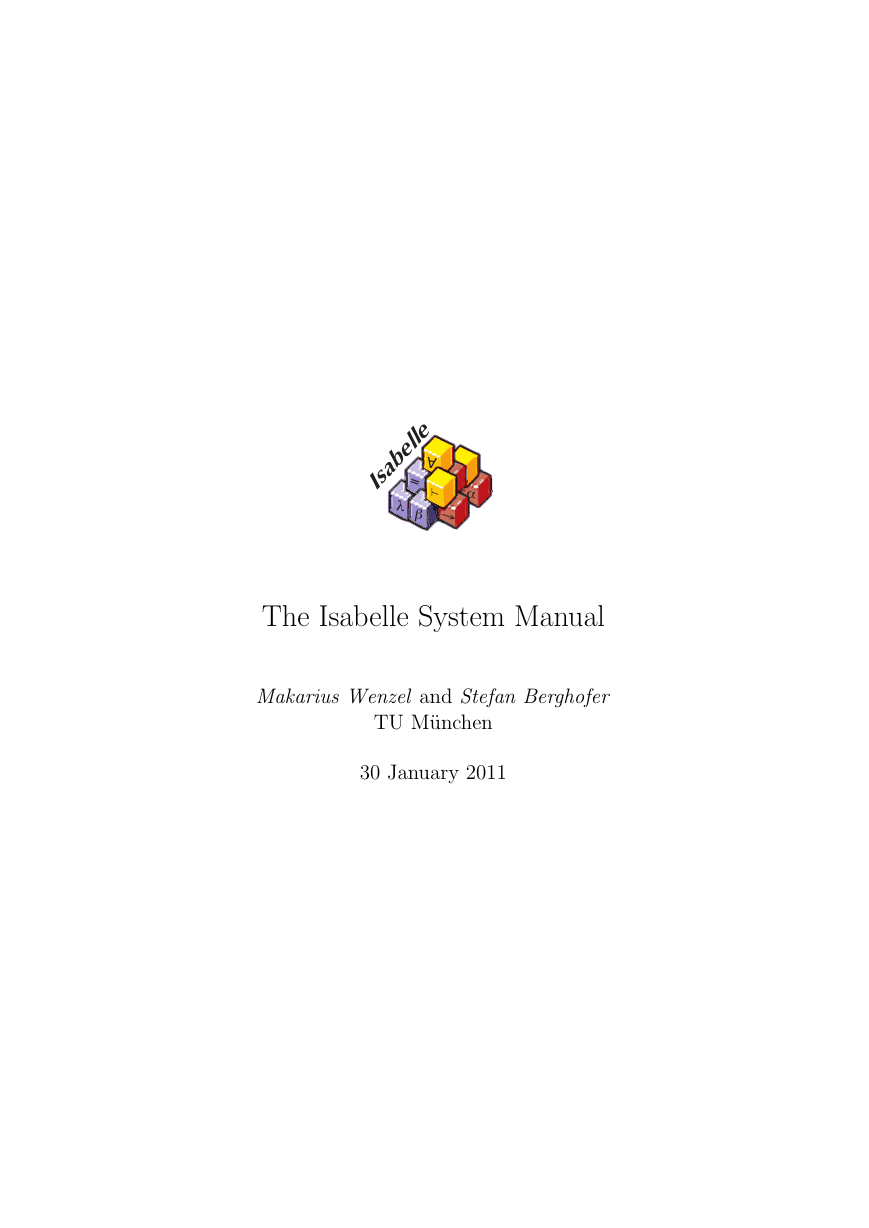
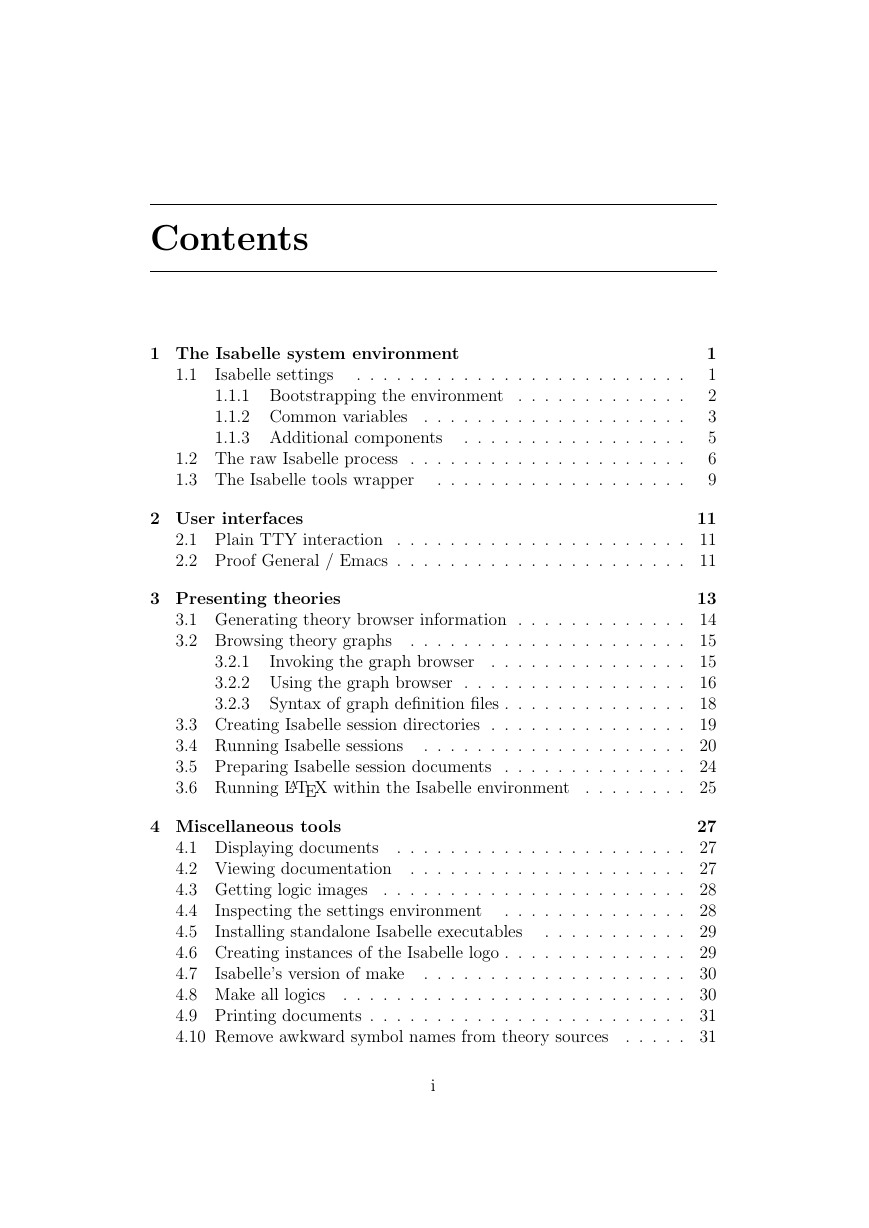


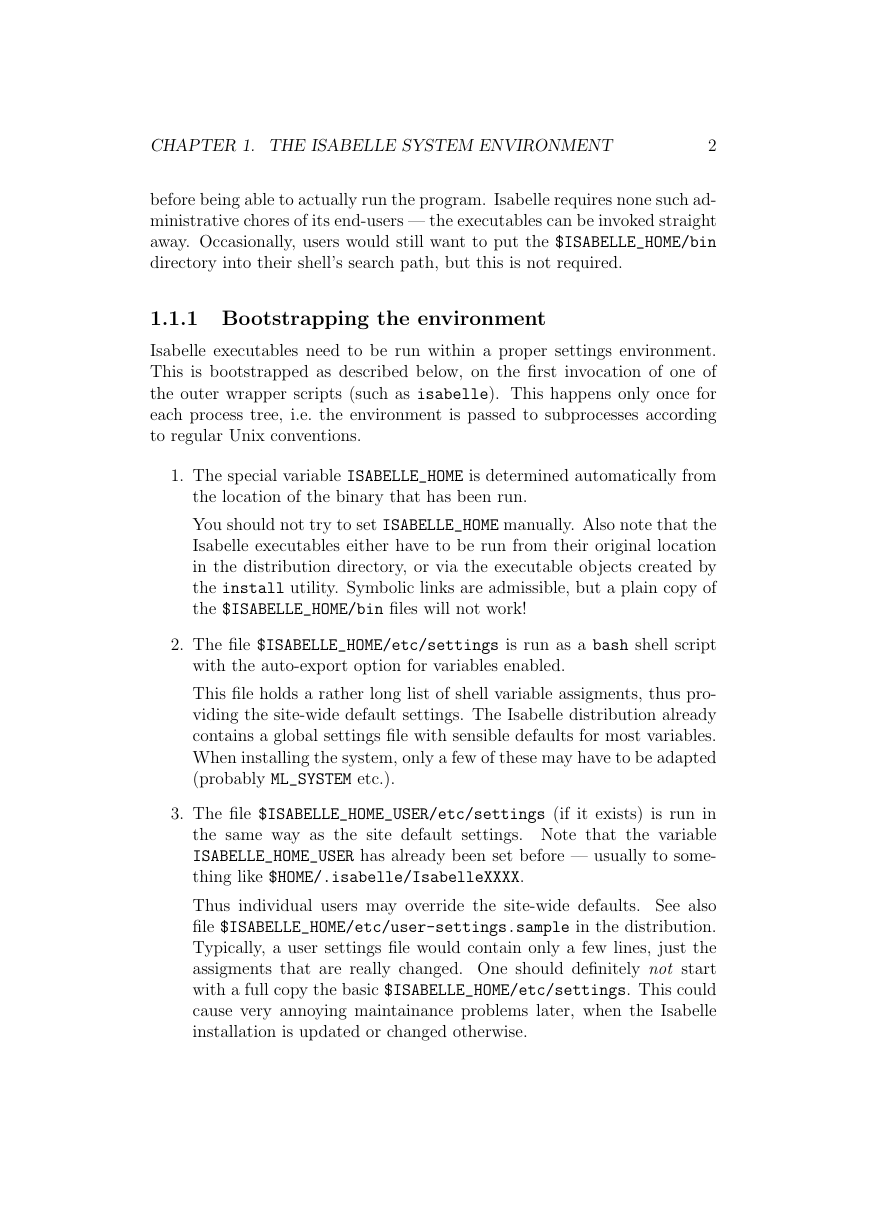
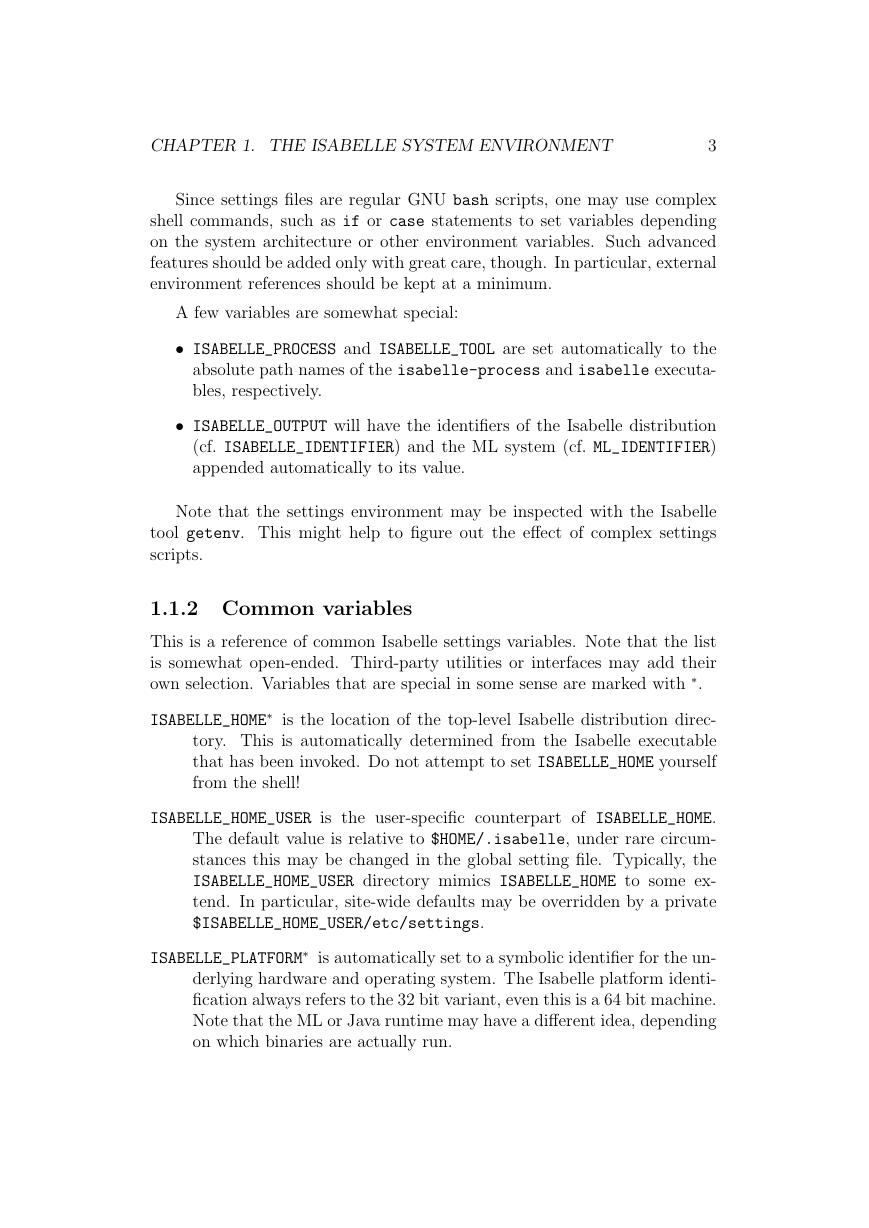
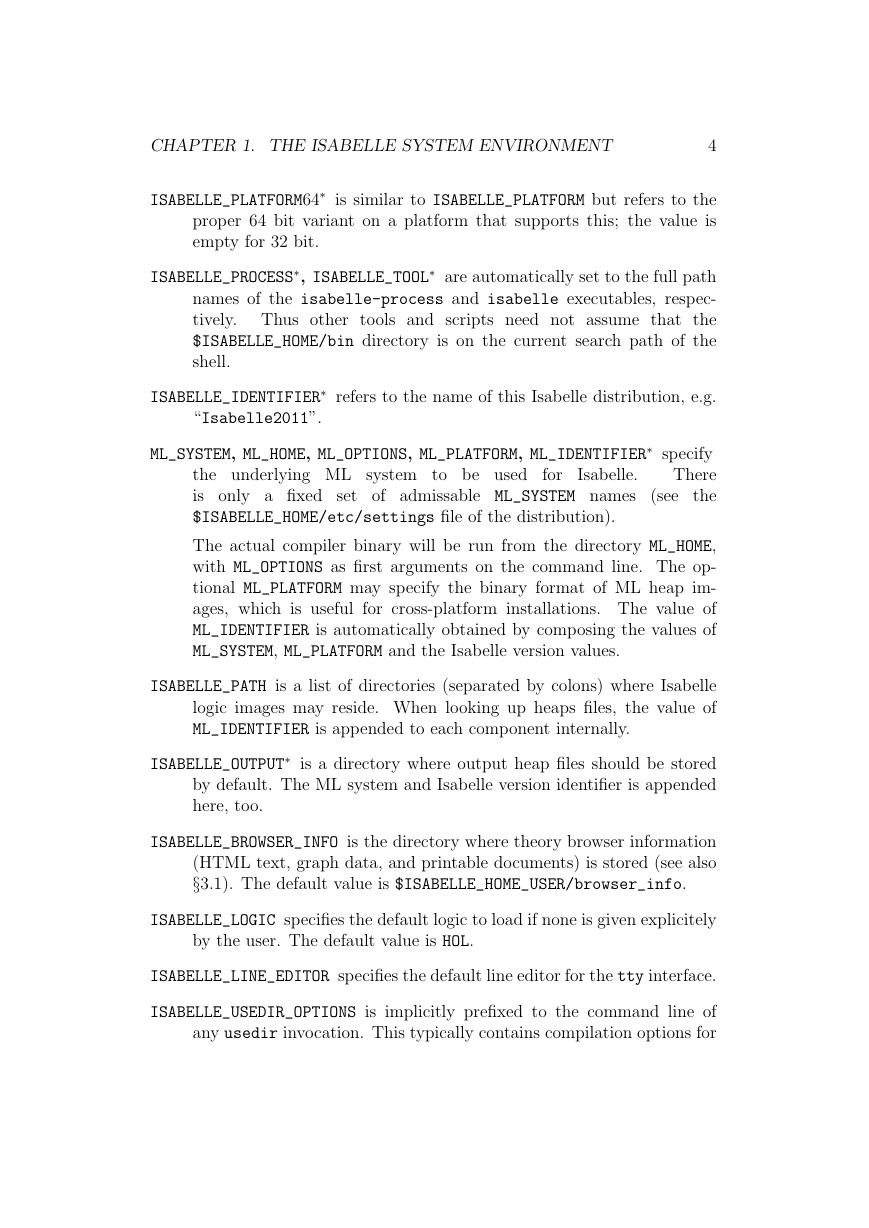
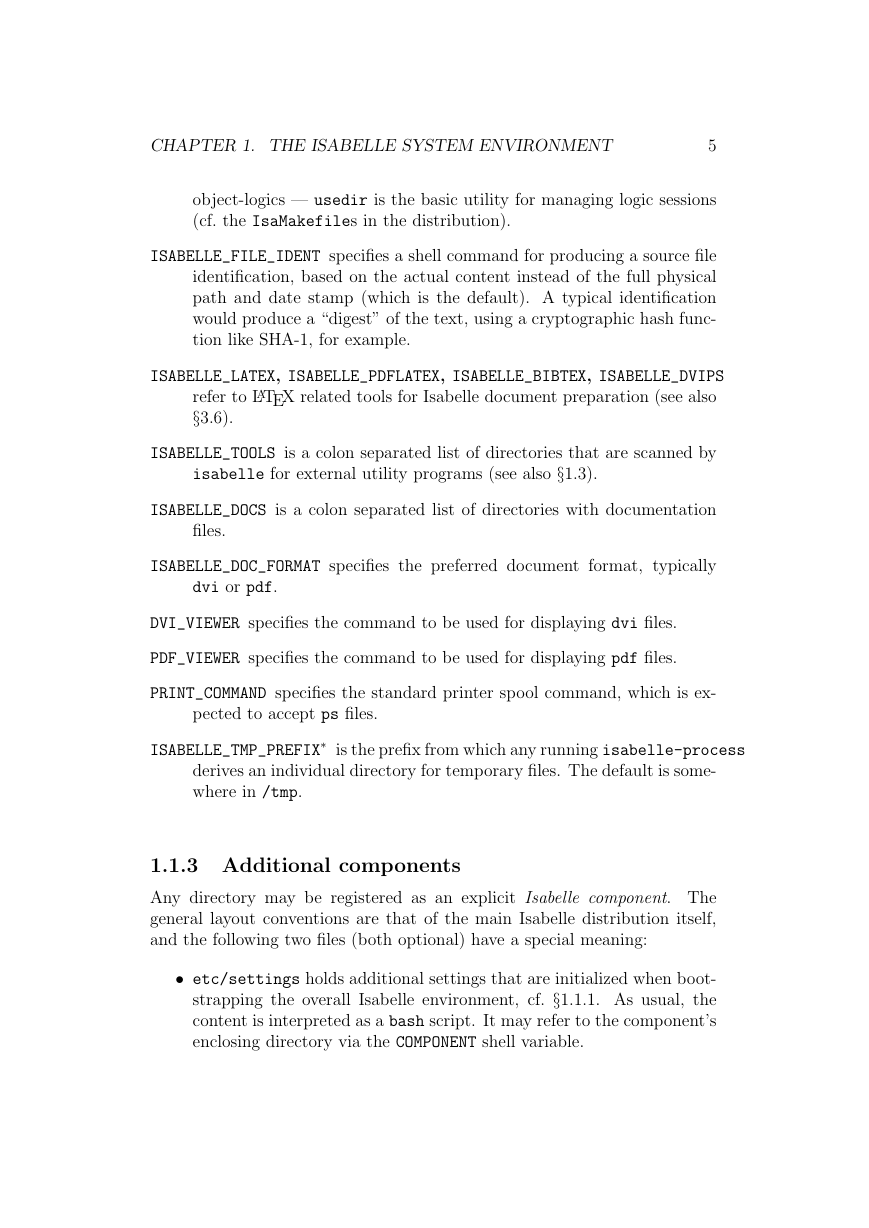








 2023年江西萍乡中考道德与法治真题及答案.doc
2023年江西萍乡中考道德与法治真题及答案.doc 2012年重庆南川中考生物真题及答案.doc
2012年重庆南川中考生物真题及答案.doc 2013年江西师范大学地理学综合及文艺理论基础考研真题.doc
2013年江西师范大学地理学综合及文艺理论基础考研真题.doc 2020年四川甘孜小升初语文真题及答案I卷.doc
2020年四川甘孜小升初语文真题及答案I卷.doc 2020年注册岩土工程师专业基础考试真题及答案.doc
2020年注册岩土工程师专业基础考试真题及答案.doc 2023-2024学年福建省厦门市九年级上学期数学月考试题及答案.doc
2023-2024学年福建省厦门市九年级上学期数学月考试题及答案.doc 2021-2022学年辽宁省沈阳市大东区九年级上学期语文期末试题及答案.doc
2021-2022学年辽宁省沈阳市大东区九年级上学期语文期末试题及答案.doc 2022-2023学年北京东城区初三第一学期物理期末试卷及答案.doc
2022-2023学年北京东城区初三第一学期物理期末试卷及答案.doc 2018上半年江西教师资格初中地理学科知识与教学能力真题及答案.doc
2018上半年江西教师资格初中地理学科知识与教学能力真题及答案.doc 2012年河北国家公务员申论考试真题及答案-省级.doc
2012年河北国家公务员申论考试真题及答案-省级.doc 2020-2021学年江苏省扬州市江都区邵樊片九年级上学期数学第一次质量检测试题及答案.doc
2020-2021学年江苏省扬州市江都区邵樊片九年级上学期数学第一次质量检测试题及答案.doc 2022下半年黑龙江教师资格证中学综合素质真题及答案.doc
2022下半年黑龙江教师资格证中学综合素质真题及答案.doc